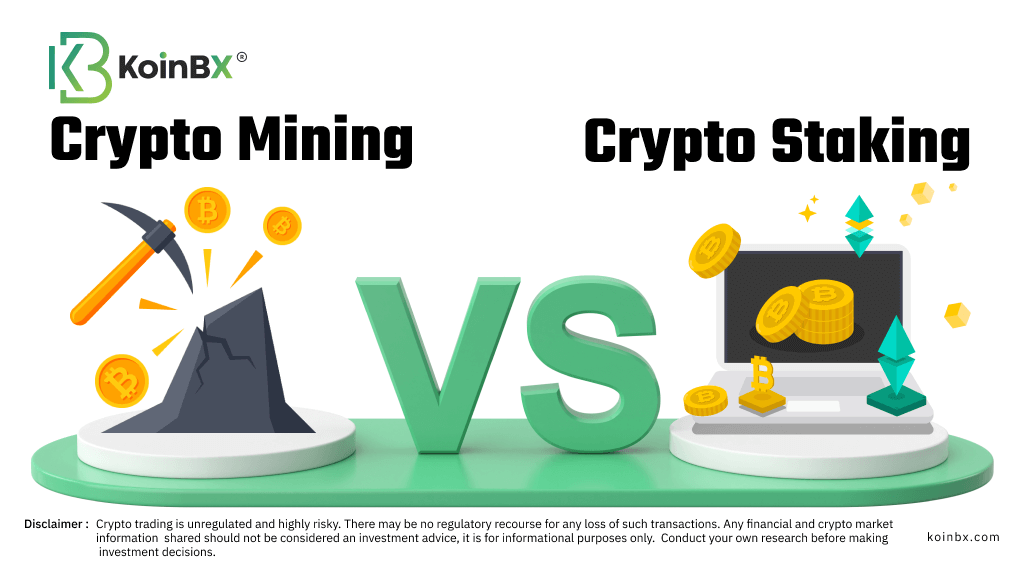Introduction
If you're interested in earning crypto asset rewards, mining and staking will be one among the popular ways. These are the two primary ways to earn digital asset, but which one is more profitable? In this article, we'll compare the two methods and explore their differences, advantages, and disadvantages. By the end of the article, you'll have a better understanding of whether mining or staking is the more profitable option for you.
What is crypto mining?
Crypto mining is all about checking and validating transactions on a blockchain network. Miners use powerful computers to solve complex math problems, called algorithms, to add new blocks to the blockchain. This process requires a significant amount of computing power and energy.
To get into mining crypto assets like Bitcoin, individuals or groups of miners need to invest in specialized hardware, such as Application-Specific Integrated Circuits (ASICs) or Graphics Processing Units (GPUs). These devices are designed specifically for the demanding tasks involved in mining, making them far more efficient than regular computers.
Miners who solve the math problems first are rewarded with newly minted coins and additional transaction fees. This is called the mining reward. The more computing power you have, the more likely you are to be the first to solve the problem and get the reward. However, as the difficulty of these problems increases for many cryptos, mining becomes more competitive and challenging.
Some of the well-known cryptos you can mine include Bitcoin, Litecoin, Monero, Bitcoin Cash, Zcash, Dash, and Ethereum Classic. But there are more, each with their own level of popularity and technical details.
What is crypto staking?
Crypto staking, in other hand, is a way to confirm and validate transactions on a blockchain without needing of computing power as mining. Instead of solving hard mathematical problems, participants in staking hold a specific quantity of crypto asset in a special wallet, called a staking wallet, to help the network run smoothly. The duration required to stake can differ based on the type of crypto asset and the staking network.
Staking plays a key role in maintaining the security of Proof of Stake (PoS) blockchains and aids in the broader acceptance of blockchain technology. By making it necessary for validators to back their own tokens, it encourages them to prioritize the network's security and maintain its integrity.
During this staking period, the tokens that have been staked are not available for trading or other transactions. In return for their involvement, participants receive rewards in the form of extra tokens, similar to the rewards miners receive for their mining efforts.
Ethereum, Cardano, Polkadot, Tezos, Cosmos, Algorand, VeChain, and TRON are among the digital assets that provide chances for staking, enabling investors to engage in the decision-making and management processes of the associated systems while receiving rewads for their involvement.
Also Read: Crypto Staking vs. Crypto Restaking
Pros and Cons of Mining
Advantages
1. Profitability: Mining can be highly profitable, especially for those with access to low-cost electricity and specialized hardware.
2. Decentralization: Mining helps keep cryptos decentralized by allowing anyone with the necessary hardware and software to participate.
3. Security: Mining contributes to the blockchain network's security by validating transactions.
4. Liquidity: Mining rewards can be sold on exchanges, providing liquidity to the market.
Disadvantages
1. Energy Consumption: Mining requires significant energy, raising environmental concerns.
2. Equipment Costs: Specialized hardware like ASICs can be expensive to purchase and maintain.
3. Centralization: Mining pools can lead to centralization if one pool gains too much control.
4. Regulatory Uncertainty: Mining may face regulatory scrutiny or restrictions in some jurisdictions.
Pros and Cons of Staking
Advantages
1. Energy Efficiency: Staking is more energy-efficient than mining, requiring no specialized hardware.
2. Decentralization: Staking maintains decentralization by allowing anyone with a stake in the network to participate.
3. Security: Staking enhances security by incentivizing users to hold and validate transactions with their crypto holdings.
4. Passive Income: Staking provides a passive income stream, allowing holders to earn rewards without active participatio
Disadvantages
1. Lower Rewards: Staking rewards are generally lower than mining rewards.
2. Lock-up Period: Staking requires locking up crypto holdings for a set period, reducing liquidity.
3. Centralization: Large holders can disproportionately influence the validation process.
4. Technical Expertise: Setting up and maintaining a staking node requires technical knowledge.
5. Regulatory Uncertainty: Like mining, staking may face regulatory scrutiny or restrictions.
Which Is Better: Crypto Mining or Staking?
The choice between mining and staking depends on several factors, including technical expertise, starting capital, and energy consumption concerns.
Mining: Mining can be more profitable, especially for those with access to cheap electricity and high-performance mining hardware. However, it demands a significant initial outlay and continuous expenses for maintenance.
Staking: Staking requires holding a certain amount of crypto, which can be less capital-intensive compared to mining. Due to it's lower energy consumption, It is also more environmentally friendly. Staking can be a long-term strategy, as the value of the staked crypto may appreciate over time.
In the end, choosing between mining and staking comes down to personal situations and objectives. It's crucial to do your own research and take into account elements such as expenses, technical needs, and possible benefits prior to deciding.
Also Read: Crypto Token vs. Crypto Coin
Final Thoughts
Crypto mining and staking are two distinct methods of participating in blockchain networks. Mining demands a lot of computing power and uses a lot of energy, but staking provides a simpler and more energy-saving option. Although both ways give out rewards for confirming and checking transactions, they are done differently.
When deciding between mining and staking, it is crucial to consider factors like technical expertise, investment capital, and environmental impact. Each method has its advantages and disadvantages, and the right choice depends on individual preferences, circumstances, and goals.
As the crypto industry continues to evolve, new consensus mechanisms and methods of earning cryptos may emerge. It is essential for users to stay informed and adapt to the changing landscape to make the most of their crypto investments. Whether choosing to mine or stake, performing due diligence and making informed decisions is critical to success in the crypto world.
Download KoinBX Android App | Download KoinBX iOS App
Disclaimer: Any financial and crypto market information shared should not be considered investment advice. It is for informational purposes only. Conduct your own research before making investment decisions. Crypto trading is unregulated and highly risky. There may be no regulatory recourse for any loss of such transactions






Comments